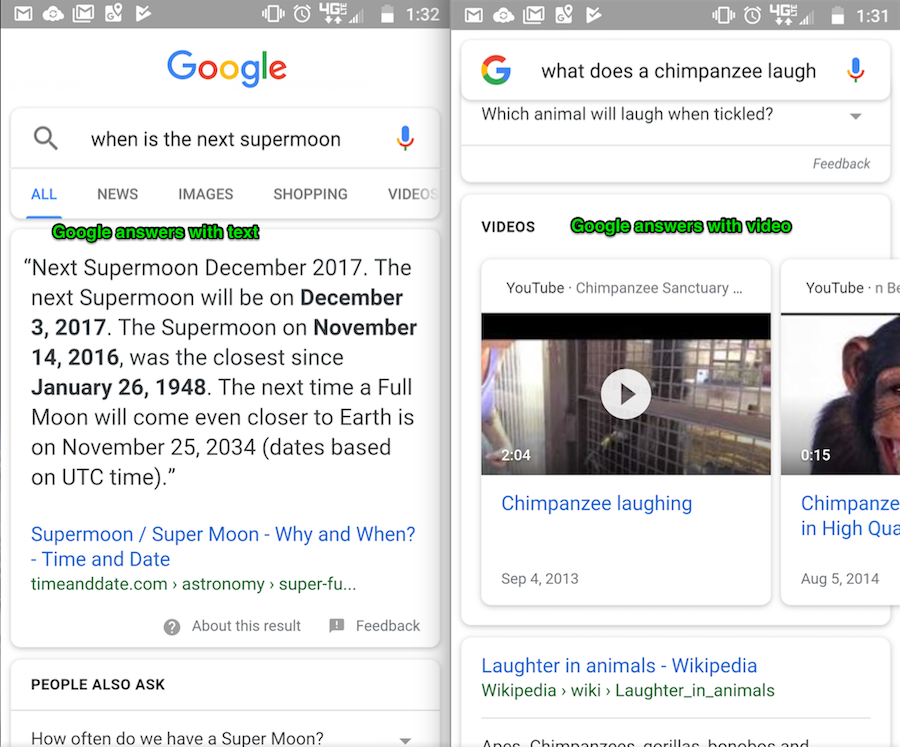
Video SEO in 2018 and Beyond
Every once in a while, Google likes to shake things up for us. They make minor to major updates every day, and one of the big ones occurred between October 11th and October 12th this year. On October 12th, the prevalence of video carousels nearly doubled across the globe. This means that whether you’re in the US or Germany, you’re going to see a lot more videos in carousels. And we find these video carousels heavily in mobile searches. If you want to see some in-depth coverage on this change, STAT Search Analytics released some pretty thorough research.
With the increased presence of videos in the SERP (search engine results page), there’s never been a better time to create a primer on ranking videos for SEO in 2018. With this guide, we’ll dive into how to make videos that rank from start to finish.
Should I Even Make a Video?
The very first question you should be asking yourself before you begin is, “Does it even make sense to make a video?” Videos will only rank in the SERP or get backlinks or shares if they are a relevant format for users. Google will only rank content that they believe is highly relevant for the query. Put another way, if you search “when is the next supermoon” you will get a featured snippet and a PAA (people also ask) box, because that question is easier and faster to answer with text. A searcher does not need a video to answer this question. But when a query requires an audio and visual response to answer it properly, video becomes much more likely to show up in the SERP. For example, try searching “what does chimpanzee laughter sound like.” When you’ve decided you want to make a video, think about what types of questions you’re trying to answer for your clients, because if you create content in the wrong format, it won’t rank no matter how much SEO effort you pour into it.

Goal Setting for SEO
The goal affects the content and the distribution, so naturally it impacts your ability to rank. When you’re planning to upload a video online you have a few different ways to do this. You can use private hosting, like Wistia, which gives you complete control. There are platforms like YouTube, which do it for free and could confer some additional benefits such as increased visibility. And then there’s the shotgun approach, which is to upload to every free channel you can, embed on all of your owned profiles, and share with anyone who might amplify your message.
If your goal is to use a video to gain backlinks, then you should use private hosting and post in only one place—your website. If you were to upload to YouTube then you could potentially cannibalize your links, as people would be equally or even more likely to link to the video in YouTube.
If your goal is to gain traffic and conversions, then go ahead and host with YouTube. It’s free, and it aids optimization efforts as Google appears to strongly favor their own product (surprise). For this you won’t focus on backlinks as much as you’ll focus on showing up in the video carousel.
And if your goal is to grow brand awareness, post that video everywhere you possibly can.
For the sake of this blog, we’ll assume you want traffic and conversions, so we’ll focus on YouTube hosting and winning SERP features. Things get a little murky here, because there’s video SEO for ranking on YouTube and there’s video SEO for ranking in the SERP, and to be honest, SEO’s don’t do a great job of separating the two out in the articles they post, leaving us to sift through confusing information with few citations. In addition, it’s unknown how much crossover the ranking signals between Google and YouTube have because Google doesn’t like to show and tell. Consequently, I’ll be making a series of recommendations that may help more for ranking in YouTube and may help more for ranking within the SERP, but either way both should serve to help you gain traffic, and none of the recommendations will hurt.
What We Know Works
When hosting on YouTube, we know a few things work:
- Including transcripts
- Including a thorough description
- Optimizing the title
- Keyword relevance
- Use of tags
- Use of closed captions
- Links to the video
- Video posted to a webpage
- Links to the webpage in profile and description
Most of these signals serve to help Google understand what the content within the video is. Remember that the algorithm cannot understand the content of a video without text clues. These are elements that give Google a better idea which queries your video would be relevant for. You need to post the video to a webpage so you have a chance to rank your website for a SERP feature. Will it likely rank the page over YouTube? Honestly, it probably won’t, Google will most likely show the YouTube link. But if your goal is traffic and conversions, then it doesn’t truly matter whether the page won placement or the YouTube channel owns that spot.
What We Think Works
In traditional SEO, we think of ranking content when it is both relevant and authoritative. For videos, I’m not sure “authority” would work. “Quality” is probably a better description. But this doesn’t have anything to do with FPS or 1080p vs 720p, rather it has to do with how engaged users are with your video. Metrics and other elements that likely play a role are:
- Watch time—how long someone sticks with your video
- Number of subscribers
- Number of views
- Enticing thumbnail image (affects CTR)
- End cards/end card CTR
- User feedback (comments, likes, and dislikes)
- Number of shares or embeds
Technical Considerations
Before you go out and try to create a video here are some technical considerations.
- Schema markup—marking up videos for schema makes it more likely they will show up as a SERP feature.
- Upload a video sitemap on your website—this makes it more likely that Google will find and index your video quickly.
- Load time—keep an eye on your video load time. Users bounce when it’s slow.
- Orientation—always shoot your videos in landscape.
- Video formats—there are a lot of different formats for videos out there. Use a common one like .mp4. YouTube currently accepts 8 video formats, but there are dozens of file extensions.
Outreach
It’s not always a case of “if you build it, they will come.” Sometimes you need to get people to the page to view the video. Does this mean ad dollars? Sometimes, yes. A few areas you can focus on to get some valuable shares, views, clicks, etc. are paid social, influencer outreach, PR pushes, and any owned channels you have. I’m not focusing a huge amount in this area because setting up paid campaigns is not hugely obscure—pretty much anyone can be walked through the process with a decent rep and existing training tools. But always keep in mind the environment in which your users are watching video. On YouTube, people are actively listening to the audio in your video, whereas on Facebook the videos are muted by default. So on Facebook you will need something to catch a user’s attention that will persuade them to turn on the sound and watch the video.
Rehash!
Okay, let’s face it, sometimes the videos tank and you get no traction. That’s alright as long as you don’t stick your head in the sand and pretend like it’s fine when it’s not working. If you are committed to this content strategy then rework the video. Tweak it, add subtitles, delete a scene, change the format, make it slideshow, etc. Then try it again. If the content is basically good it could be a simple delivery issue where it needs to be presented in just the right way to gain traction.
And maybe you ignored me up above when I said to make sure that the users needed a video. Maybe your video should be plain text. Or maybe video is fine, but it should be a webinar to meet business objectives, and SEO is not the right channel for that video. Despite its widespread accessibility and the success many businesses enjoy with SEO, it’s not a silver bullet and shouldn’t be an assumptive solution for every campaign.
And some of you reading this are probably thinking about videos you put up already and wondering if you can go back and alter it to make it rank. In some cases, sure! However, skip the effort if you’re posting a commercial on your website. Highly commercialized video ads that don’t serve a user’s needs and focus only on the business’s needs do not rank. If you type “are hurricane proof windows worth it?” on Google, you get a news report about these types of windows. It does a good job of answering the question, whereas a commercial will not. Even if the commercial perfectly answers the question, there is a conflict of interest. And if users do not trust it, they will not watch it, share it, or link to it, and remember that many of those engagement metrics highly correlate with ranking videos in the SERP and elsewhere.
Conclusion
For 2018 and beyond the signals that impact video SEO seems to marry well to the signals that seem to impact regular SEO. Quality and relevance of the content, technical aspects, engagement, and backlinks are the primary drivers of rankings and traffic. Focusing on these elements will yield a video SEO strategy that stands the test of time.



